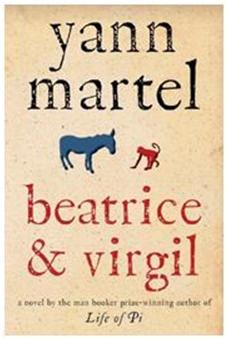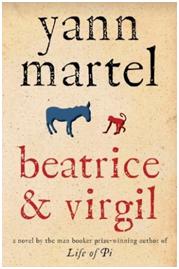 I am really struggling with this book – normally I pick up a book and begin reading. The plot will unfold and by the third chapter I will have the map of the unknown country described by the author in my head. But here it is a different story. I was struggling so much that I have had to resort to reading reviews etc. just to be able to grasp what this book is about.
I am really struggling with this book – normally I pick up a book and begin reading. The plot will unfold and by the third chapter I will have the map of the unknown country described by the author in my head. But here it is a different story. I was struggling so much that I have had to resort to reading reviews etc. just to be able to grasp what this book is about.
The book is an attempt to show how the holocaust can be depicted in art – or perhaps how it should be depicted in various forms of art.
Who are Beatrice and Virgil? These are the guides in Dante’s Divine Comedy. But here they are a donkey and a howler monkey, occupying the space between not alive and not dead.
The more reviews I read, the more confused I become. The main protagonist is an author called Henry who wrote an absurdly successful book and now is struggling to launch another magnum opus. And out of the blue, another Henry, this one a taxidermist, contacts Henry about a play he is trying to write. The characters are in fact stuffed animals in the taxidermist’s shop and the play is called “The 20th Century Shirt”. And the big question to be answered “How are we going to talk about what happened to us one day when it is over”? And so the allusions to the holocaust and representations in art.
This is a book that has to be read carefully and I am proceeding slowly. My problem is that this is a digital library book and expires in 3 days. Perhaps I will renew it.
 I finished the book. It is quite short and very surreal. What is it about?
I finished the book. It is quite short and very surreal. What is it about?